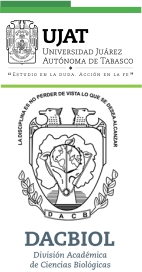SUSTITUCIÓN TOTAL DE ACEITE DE PESCADO CON ACEITE VEGETAL EN LARVAS DE PEJELAGARTO Atractosteus tropicus
DOI:
https://doi.org/10.19136/kuxulkab.a15n28.443Resumen
Se efectuó un bioensayo en larvas del "Atractosteus tropicus", para lo cual se seleccionaron un total de 1,054 individuos con un peso y longitud inicial de (0.08±0.01 g y 26.0±3.0 mm respectivamente) aplicando un diseño bifactorial, donde el primer factor fueron los dos tipos de aceites; vegetal (Patrona, Edo. Mex) y sardina, el segundo factor fueron los dos niveles de lípidos 10 y 15%, más la dieta control comercial para trucha, (Silver Cup®) con 45% de proteína y 16% de lípidos, evaluados por triplicado con una duración de 28 días. Los resultados mostraron que las larvas alimentadas con la dieta (SOL10%) y aceite de pescado con 15% de lípidos (SOL15%), fueron estadísticamente diferentes entre sí y las que mejores pesos y longitudes totales obtuvieron (3.76±0.55 g y 12.13±1.25 mm; 1.46±0.37 g; 7.31±0.67mm) contra las larvas alimentadas con las dietas de control y aceites vegetales (CDPL16%, VOL10% y VOL15% de lípidos). Por lo que se concluye que en la alimentación de las larvas de "A. tropicus" se debe usar aceite de sardina, aunque la utilización de aceites vegetales es posible, no obstante probablemente en menor cantidad.Descargas
Referencias
Álvarez-González, C.A., Civera-Cerecedo, R., Ortíz-Galindo, J.L., Dumas, S., Moreno-Legorreta, M. & Grayeb-Del Alamo, T. 2001. Effect of dietary protein level on growth and body composition of juvenile spotted sand bass, Paralabrax maculatofasciatus, fed practical diets. Aquaculture, 194: 151-159.
Carta Nacional Pesquera. 2004. México. Secretaría de Agricultura, Ganadería, Desarrollo Rural, Pesca y Alimentación. Diario Oficial de la Federación, Órgano del Gobierno Constitucional de los Estados Unidos Mexicanos.
Díaz-Cruz A, Serret, M., Ramírez, G., Ávila, E., Guinzber & R., Piña, E. 2003. Prophylactic action of lipoid acid on oxidative stress and growth performance in broilers at risk of developing as cites syndrome. Avian Pathol, 32: 645-653
Grant, A.M. 2006. Growth, fatty acid composition and Na+ /K+-ATPase isoform physiology of juvenile Chinook salmon Oncorchynchus tshawytscha fed diets supplemented with anchovy or blends of anchovy and canola oil. MSc. Thesis University of British Columbia, Vancouver, Canada, Pp: 35-61
Hei-Zhao, L., Yong-Jian, L., Jian-Guo, H., Wen- Hui, Z. & Li-Xia, T. 2006. Alternative vegetable lipid sources in diets for grouper, Epinephelus coioides (Hamilton): effects on growth, and muscle and liver fatty acid composition. Aquaculture Research, 2007(38): 1605-1611
Hei-Zhao, L., Yong-Jian, L., Jian-Gu, H., Wen-Hui, Z. & Li-Xia, T. 2007. Alternative vegetable lipid sources in diets for grouper, Epinephelus coioides, Hamilton: effects on growth, and muscle and liver fatty acid composition. Aquaculture Research, 38: 1605-1611
Heller, G.H. 2006. The effect of dietary lecithin and lipase, as a function of age, on n9 fatty acid incorporation in the tissue lipids of Sparus aurata. Fish Physiology and Biochemistry, 10: 357-364
Izquierdo, M.S., Obach, A., Arantzamendi, L., Montero, D., Robaina, L. & Rosenlund, G. 2003. Dietary lipid sources for seabream and seabass: growth performance, tissue composition and flesh quality. Aquaculture Nutrition, 9: 397-407
Lee, S.M., Jeon, I.G. & Lee, J.Y., 2003. Effects of digestible protein and lipid levels in practical diets on growth, protein utilization and body composition of juvenile rockfish Sebastes schlegeli. Aquaculture, 211: 227-39
Márquez, C.G., Álvarez, G.C.A., Contreras, S.W.M., Hernández, V.U., Hernández, F.A.A., Mendoza, A.R.E., Aguilera, G.C., García, G.T., Civera, C.R. & Goytortúa, B.E. 2006. Avances en la alimentación y nutrición del pejelagarto Atractosteus tropicus. Avances en nutrición acuícola. 15-17 Noviembre. Universidad Autónoma de Nuevo León, Monterrey, Nuevo León, México.
Miller, R.R., Minckley, W.L. & Norris, S.M. 2005. Freshwater Fishes of México. The University of Chicago Press. Chigago. 450 p.
Mourente, G., Good, J.E. & Bell, J.G. 2005. Partial substitution of fish oil with rapeseed, linseed and olive oils in diets for European sea bass Dicentrarchus labrax L. effects on flesh fatty acid composition, plasma prostaglandins E2 and E2 ∞,immune function and effectiveness of a fish oil finishing diet. Aquaculture Nutrition, 11: 25–40
Ng, W.K., Tocher, D.R. & Bell, J.G. 2007. The use of palm oil in aquaculture feeds for Salmonid species. Review. European Journal of Lipid Science and Technology, 109: 394-399
Shapawi, R., S., Saleem, M., & Wing-Keong, N., 2008. Effects of dietary fish oil replacement with vegetable oils on growth and tissue fatty acid composition of humpback grouper, Cromileptes altivelis (Valenciennes). Aquaculture Research, 39: 315-323
Spurlock, M.E. & Savage, J.E., 1993. Effect of dietary protein and selected antioxidants on fatty liver hemorrhagic syndrome induced in Japanese quail. Poultry Sci., 72: 2095-2105
Torstensen, B.E., Frøyland, L. & Lie, Ø., 2004. Replacing dietary fish oil with increasing levels of rapeseed oil and olive oil-effects on Atlantic salmon Salmo salar L. tissue and lipoprotein lipid composition and lipogenic enzyme activities. Aquaculture Nutrition, 10: 175-192
Torstensen, B.E., Bell, J.G., Sargent, J.R., Rosenlund, G., Henderson, R.J., Graff, I.E., Lie, Ø. & Tocher, D.R., 2005. Tailoring of Atlantic salmon Salmo salar L. flesh lipid composition and sensory quality by replacing fish oil with a vegetable oil blend. J. Agric. Food Chem., 53: 10166-10178
Turchini, G.M., Mentasti, T., Frøyland, L., Orban, E., Caprino, F., Moretti, V.M., & Valfré, F. 2003. Effects of alternative dietary lipid sources on performance, tissue chemical composition, mitochondrial fatty acid oxidation capabilities and sensory characteristics in brown trout Salmo trutta L. Aquaculture, 225: 251-267
Wu, F.C., Ting, Y.Y. & Chen, H.Y., 2002. Docosahexaenoic acid is super ior to eicosapentaenoic acid as the essential fatty acid for growth of grouper, Epinephelus malabaricus. Journal of Nutrition, 132: 72-79
Descargas
Publicado
Número
Sección
Licencia
Los autores que publiquen en Kuxulkab' aceptan las siguientes condiciones como política de acceso abierto:
1. Que conservan los derechos de autor y ceden a la revista el derecho de la primera publicación, con el trabajo registrado con la licencia de atribucion de "Creative Commons", que permite a terceros utilizar lo publicado siempre que mencionen la autoría del trabajo y a la primera publicación en esta revista.
2. El autor puede realizar otros acuerdos contractuales independientes o adicionales para la distribución no exclusiva de la versión del artículo publicado en esta revista, como por ejemplo incluirlo en un repositorio institucional o publicarlo en un libro, siempre que se indique claramente que el trabajo se publicó por primera vez en esta revista.













